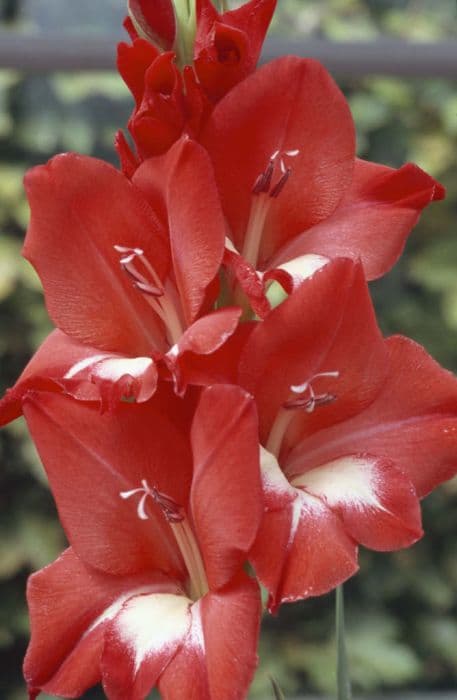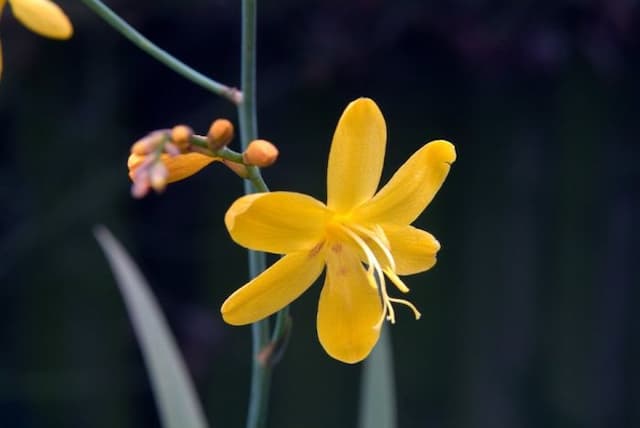Gladiolus Gladiolus 'Trader Horn' (G)

ABOUT
The Gladiolus 'Trader Horn' is a striking plant known for its showy and vibrant flowers. It boasts tall flower spikes adorned with large, funnel-shaped blooms that create a bold visual statement. The flowers come in a fiery red color with subtle throat markings that can be either white or a lighter shade of red, enhancing their appeal. These blooms are arranged in a double row along the stems, each one unfurling in succession from the bottom to the top. The plant's leaves are long, slender, and sword-shaped, which complement the vertical orientation of the flower spikes. The overall appearance of Gladiolus 'Trader Horn' is one of dramatic elegance, with its vivid flowers making it a favorite in gardens and as cut flowers in arrangements.
About this plant
 Names
NamesFamily
Iridaceae
Synonyms
Sword Lily, Gladiolus, Glads
Common names
Gladiolus 'Trader Horn'.
 Toxicity
ToxicityTo humans
Gladioli are not considered highly toxic to humans. However, they can still cause mild symptoms if ingested. Eating parts of the gladiolus plant can lead to symptoms such as throat irritation, nausea, vomiting, and diarrhea.
To pets
Gladioli are considered to be mildly toxic to pets, such as dogs and cats. If a pet ingests part of a gladiolus plant, it may experience symptoms including drooling, nausea, vomiting, diarrhea, and lethargy. In more severe cases, the consumption could lead to abdominal pain or an irregular heartbeat, and it is recommended to consult with a veterinarian if a pet has ingested this plant.
 Characteristics
CharacteristicsLife cycle
Perennials
Foliage type
Deciduous
Color of leaves
Green
Flower color
Red
Height
4 feet (1.2 meters)
Spread
1 foot (0.3 meters)
Plant type
Bulb
Hardiness zones
7
Native area
South Africa
Benefits
 General Benefits
General Benefits- Vibrant Colors: The Gladiolus 'Trader Horn' blooms with vivid red flowers, adding a striking splash of color to any garden or floral arrangement.
- Attracts Pollinators: Its bright flowers can attract bees, butterflies, and other beneficial pollinators, helping to maintain the health of your garden's ecosystem.
- Vertical Interest: The tall flowering spikes can add height and structure to garden beds, borders, and containers, providing a vertical element in your landscape design.
- Cut Flower: The long stems and large blooms of Gladiolus 'Trader Horn' make it an excellent choice for cut flower arrangements, bringing beauty indoors.
- Seasonal Bloomer: Blooming in mid to late summer, it offers a burst of color when many other plants may be past their peak.
- Easy to Grow: This cultivar is known for being hardy and relatively easy to care for, making it a good choice for both novice and experienced gardeners.
- Bulb Propagation: The corms (bulbs) of the plant can be easily divided and shared or moved to propagate new plants, making it cost-effective.
 Medical Properties
Medical PropertiesThis plant is not used for medical purposes.
 Air-purifying Qualities
Air-purifying QualitiesThis plant is not specifically known for air purifying qualities.
 Other Uses
Other Uses- Crafts and Decorations: The vibrant and sturdy stalks of gladiolus can be used for creating homemade jewelry such as necklaces or head wreaths, especially during summer festivals.
- Plant Supports: When gladiolus stalks dry out, they can be used as natural, biodegradable stakes for supporting other plants in the garden.
- Flower Arranging Classes: Gladiolus flowers are popular choices for teaching flower arranging techniques due to their impressive height and variety of colors.
- Floating Decorations: Individual gladiolus flowers can be floated in large glass bowls as centerpieces for events or as a serene home decoration.
- Educational Purposes: Gladiolus plants can serve as a tool for teaching botany or horticulture, especially the process of bulb propagation and flowering patterns.
- Photography: With their striking appearance, gladiolus flowers are often used by photographers as subjects for botanical photography and art projects.
- Bee and Butterfly Gardens: By planting gladiolus, gardeners can create attractive habitats for pollinators like bees and butterflies in environmental conservation efforts.
- Dye Production: The petals of gladiolus flowers may be used in small-scale, natural dye production for fabrics and crafts.
- Fragrance Extraction: Although not commonly known for their scent, the subtle fragrance of some gladiolus variants can be captured and used in homemade potpourris.
- Bookmark Crafting: Pressed gladiolus flowers can be laminated and used as delicate and personalized bookmarks for enthusiasts of both reading and gardening.
Interesting Facts
 Feng Shui
Feng ShuiThe plant Gladiolus is not used in Feng Shui practice.
 Zodiac Sign Compitability
Zodiac Sign CompitabilityThe plant Gladiolus is not used in astrology practice.
 Plant Symbolism
Plant Symbolism- Strength of Character: The Gladiolus, also known as the "sword lily," symbolizes strength and integrity, owing to its long, strong stems that stand upright and resemble swords.
- Remembrance: It is often used to commemorate the life of a lost loved one or an event that one does not want to forget.
- Infatuation: With its striking and bold blooms, it signifies to the recipient a fascination or piercing of the heart, indicating that the giver is captivated by their charms.
- Moral Integrity: In the language of flowers, the Gladiolus is often associated with sincerity and honesty, representing strong moral values.
- Persistence and Determination: The towering blooms of the Gladiolus depict the drive to overcome obstacles, suggesting resilience and perseverance in the face of challenges.
 Water
WaterWater your Gladiolus 'Trader Horn' deeply whenever the top 2 inches of soil feel dry to the touch, typically once a week. During the growing season, they may need more frequent watering, possibly twice a week, depending on weather conditions. Use about 1 gallon of water per plant each time you water, ensuring you moisten the soil without waterlogging it. It's important to avoid overhead watering to prevent disease, and instead water at the base of the plant. In the absence of rain, total water use for the plant should not exceed 2 gallons per week.
 Light
LightGladiolus 'Trader Horn' prefers full sun conditions to thrive. The best spot for planting is an area that receives direct sunlight for at least 6 hours a day. Avoid places that are shaded for long periods, as inadequate light can lead to poor flower development.
 Temperature
TemperatureThe Gladiolus 'Trader Horn' tolerates a temperature range from approximately 50 to 90 degrees Fahrenheit, with the ideal growing temperature around 70 to 75 degrees Fahrenheit. They can survive brief periods of cooler temperatures down to 35 degrees Fahrenheit, but freezing temperatures will damage the plant.
 Pruning
PruningPrune your Gladiolus 'Trader Horn' by removing spent flower spikes to encourage further blooming and to maintain a tidy appearance. This should be done as soon as the flowers fade. Additionally, cut back foliage after it has died back naturally in the fall, before the first frost. Pruning is not extensive for Gladioli but is essential to prevent disease and to ready the plant for the next growing season.
 Cleaning
CleaningAs needed
 Soil
SoilGladiolus (commonly known as Sword Lily) thrives best in a well-draining soil mix with a soil pH of 6.0 to 6.5. A mix composed of loamy soil, sand, and compost is ideal to ensure proper drainage and fertility. Regular enrichment with organic matter will encourage robust growth.
 Repotting
RepottingSword Lilies are not commonly repotted as they grow from corms that are planted annually. After flowering, the corms are usually lifted and stored during winter and replanted in the spring.
 Humidity & Misting
Humidity & MistingSword Lilies prefer moderate humidity levels but are quite adaptable and can thrive in the varying humidity conditions typically found outdoors.
 Suitable locations
Suitable locationsIndoor
Use well-draining soil, bright indirect light.
Outdoor
Plant in full sun, well-drained soil, after last frost.
Hardiness zone
7-10 USDA
 Life cycle
Life cycleGladiolus 'Trader Horn' initiates its life cycle when its corm, a bulb-like storage organ, is planted in well-drained soil with adequate sunlight. After planting, the corm sprouts and produces tall, sword-shaped leaves, with a flower spike eventually emerging to display brilliant red flowers typical of the 'Trader Horn' variety. Following flowering, which occurs in summer to early fall, the plant undergoes pollination, potentially facilitated by insects, leading to the development of small seeds. As the flowering period ends, the plant begins to die back, with the foliage turning yellow and withering as the corm enters a dormant phase; in colder climates, the corms are often lifted from the ground and stored until the next growing season. If left to naturalize, or if the seeds are collected and sown, new plants will germinate and grow, completing the cycle. With proper care, 'Trader Horn' gladiolus can reemerge each year from the same corm or from new cormlets that form around the base of the parent corm.
 Propogation
PropogationPropogation time
Spring to Summer
Gladiolus 'Trader Horn', commonly known as gladiolus, is typically propagated through the division of corms. The best time to propagate is in the spring after the threat of frost has passed and the soil has warmed up. To propagate, you begin by gently lifting the corms from the ground using a spade, taking care not to damage them. Once lifted, the corms which are essentially swollen stem bases, should be separated, ensuring that each section has at least one growing point. The old, spent mother corm from the previous year, found at the bottom, is generally discarded if it can be easily detached. The new corms can then be replanted at a depth of about 4 to 6 inches (approximately 10 to 15 centimeters), spaced 5 inches (about 12.7 centimeters) apart in well-draining soil with good sun exposure. This method capitalizes on the natural reproductive cycle of gladiolus and ensures the cultivation of genetically identical plants season after season.









